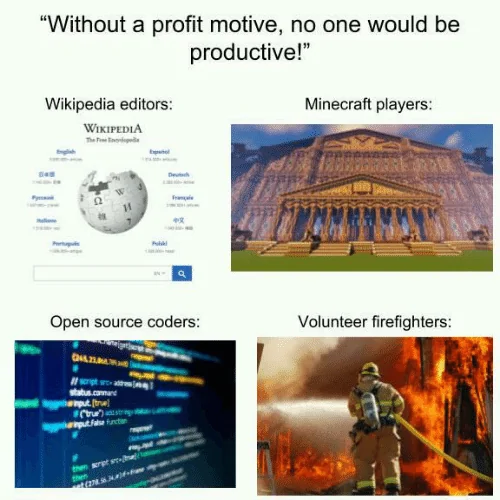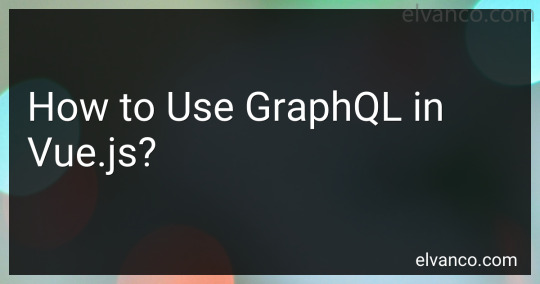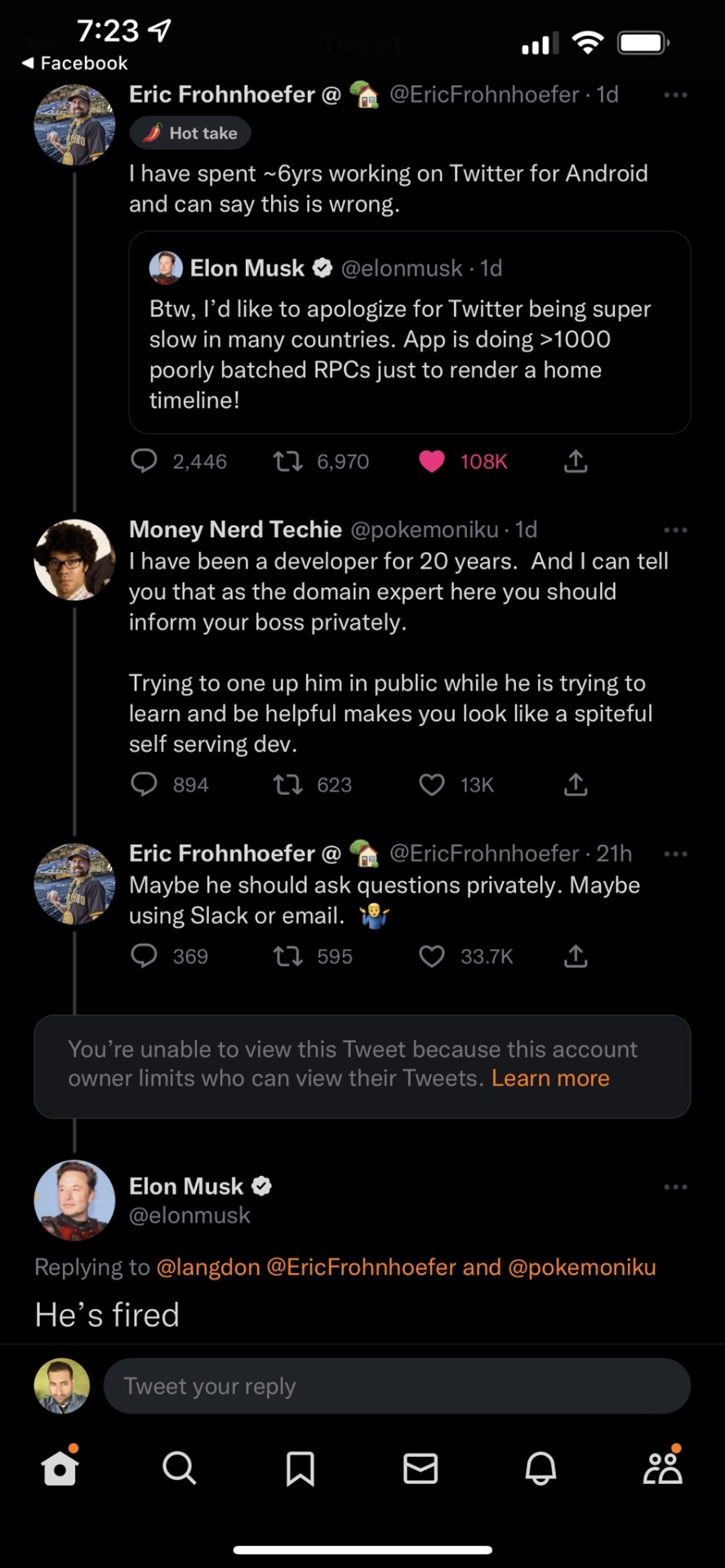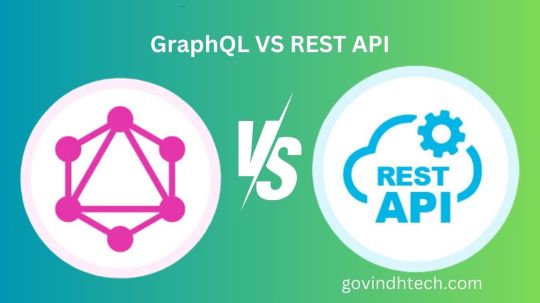#graphql
Text

join praxis now - discord - github
2K notes
·
View notes
Text
Has anyone found a way to use both GraphQL Shield and dataloaders at the same time while using Apollo Server and NestJS?
I recently found that because I have asynchronous calls being made in some of my shield rules, it's causing my dataloader batch functions to be called multiple times, when they should only be called once, which leaves me with the N+1 problem across my entire app.
I believe this is due to how dataloader requires that all of the batch function calls occur during the same event loop "tick", and the async calls in my shield rules are preventing this.
Here's where I asked the question on reddit
27 notes
·
View notes
Text
How to Use GraphQL in Vue.js?

Read more at: https://elvanco.com/blog/how-to-use-graphql-in-vue-js
8 notes
·
View notes
Text
i think this endpoint has been STITCHED. TOGETHER. WRONG.
3 notes
·
View notes
Text
GraphQL vs REST – Which one is Better and Why?

GraphQL is a successor to REST, the standard way to create an application programming interface (API). GrapghQL is different from REST as it is a query language, rather than an abstraction for network-based software.
GraphQL was developed by a team at Facebook in 2012 and publicly released in 2015. The project was transferred from Facebook to the newly founded GrapghQL Foundation, which the Linux Foundation non-profitably hosted.
The differentiation between REST and GraphQL is that one trip to the server is needed in GraphQL thus it makes the data-retrieving process much faster, and the response is sent back in JSON format. Whereas, when fetching data using the REST model multiple rounds of trips to the server needed to be made to get the required data for the application, which can be slow, mostly on mobile devices.
Not everyone comprehends yet what GraphQL is all about, or why it is increasing in popularity for GrapghQL as a successor to REST APIs. The goal is to provide a brief illustration to anyone who still has not got to know GraphQL and clarify exactly what it does better than REST.
See why GrapghQL is better than REST, and why working with GrapghQL can increase data access and efficiency apart from REST.
3 notes
·
View notes
Text



Elon fires Twitter engineer who corrects him on Twitter engineering.
2 notes
·
View notes
Text
ネットスーパーアプリのリプレイスにおける技術選定と実装
本記事では、既存のネットスーパーアプリをリプレイスする際の課題と対応策について説明している。既存のシステムではGraphQLを使用していたが、持続的なプロダクト開発が難しかったため、RESTに移行しOpenAPI定義書を活用したスキーマ駆動開発を実践している。また、sqlboilerを使ってデータベースのテーブル定義からGoの構造体を自動生成することで、小売業者ごとのカスタマイズにも対応できるようにしている。
リプレイスを行うにあたっては最終系から逆算して必要なことをまとめておくことが重要だと指摘されている。また、言語の違いから生じる学習コストについても言及されており、新しい技術に触れる良い機会になったと述べられている。このように、リプレイスプロジェクトを通して技術面だけでなく組織面でも得られる知見は少なくないと考えられる。
0 notes
Text
A Comprehensive Presentation on Jannah Middleware Application Part 9: Continuing with Django Settings File
A Comprehensive Presentation on Jannah Middleware Application Part 9: Continuing with Django Settings File
Continuing with Django SettinA Comprehensive Presentation on Jannah Middleware Application Part 9: Continuing with Django Settings File
Video Highlights
We talked about the following variables in the Django settings.py file:
DEBUG
ALLOWED_HOSTS
INSTALLED_APPS
GRAPHENE
MIDDLEWARE
ROOT_URLCONF
We discussed using these variables in the settings file to setup security options for middleware…

View On WordPress
#&039;gotcha&039;#compute#computer science#CRUD#Data#Database#Discovery#django#Educational Trip#Eye-Opening#graphene#GraphQL#graphs#handler#istio#jannah.io#kubeflow#Models#mutation#PostgresDB#python#quirks#resolver#settings#Sightseeing#Software Developer#Software Engineering#Software Services#Students#Tech Business Developers
0 notes
Text
REST API vs GraphQL API: Choosing an API Which You Need

REST API vs. GraphQL APIs: A Developer Showdown
APIs power modern online services by connecting software components and transferring data across the internet. API technologies like SOAP, REST, and GraphQL facilitate software development by integrating third-party data and services. APIs allow firms to securely communicate data and provide services to workers, business partners, and users.
Recent disputes have focused on REST (representational state transfer) and GraphQL, despite the various APIs. Both have several advantages and are used in networking projects worldwide. Data traffic management differs greatly between them. IBM compare REST and GraphQL APIs and explain how corporations may optimise their networks.
Explain REST and GraphQL APIs
Comparing REST and GraphQL APIs requires knowledge of each.
REST
The early 2000s-developed REST architecture paradigm for networked hypermedia applications uses a stateless, client/server, cacheable communication protocol. RESTful APIs drive REST designs.
REST APIs address resources using URIs. REST APIs use endpoints to execute CRUD (“create,” “read,” “update,” and “delete”) network resource activities. They shape and size client resources based on a media type or MIME type. Most formats are JSON and XML (occasionally HTML or plain text).
The server handles client requests for resources and returns all related data. HTTP response codes include “200 OK” for successful REST queries and “404 Not Found” for missing resources.
GraphQL
In 2012, Facebook created GraphQL, a query language and API runtime that became open source in 2015.
API schema published in GraphQL schema definition language defines GraphQL. Each schema lists data types and associations the user may query or alter. The resolver backs each schema field. The resolver converts GraphQL queries, modifications, and subscriptions into data and fetches it from databases, cloud services, and other sources. Resolvers specify data formats and let the system combine data from several sources.
Instead of utilising several endpoints to acquire data and conduct network operations like REST, GraphQL exposes data models by using a single endpoint for all GraphQL queries. Using resource attributes and resource references, the API gets the client all the data they need from a single query to the GraphQL server.
GraphQL and REST APIs are resource-based data exchanges that employ HTTP methods like PUT and GET to limit client actions. However, important contrasts explain why GraphQL has grown and why RESTful systems have endured.
REST API vs GraphQL API
GraphQL APIs are typically considered an enhancement over RESTful settings due to their ability to promote front-end-back-end team cooperation. An organization’s API journey should continue with GraphQL, which solves REST difficulties.
REST was the norm for API designs, and many developers and architects still use RESTful settings to manage IT networks. Understanding the differences is crucial to any IT management plan.
REST and GraphQL APIs handle differently:
Data retrieval
REST uses many endpoints and stateless interactions to handle each API request as a new query, so clients obtain all resource data. Over-fetching occurs when a client only wants a portion of the data. To make up for under-fetching, a RESTful system frequently requires clients query each resource individually if they need data from numerous resources. Single-endpoint GraphQL APIs eliminate over- and under-fetching by providing clients with an accurate, full data response in one round trip from a single request.
Versioning
Teams must version APIs to adjust data structures and avoid end-user errors and service outages in a REST architecture. Developers must establish a new endpoint for every update, producing several API versions and complicating maintenance. GraphQL eliminates versioning since clients may express data needs via queries. Clients without need for new server fields are unaffected. Clients may request deprecated fields until queries are updated.
Error handling
HTTP status codes indicate request success or failure in REST APIs. Each status code has a purpose. A successful HTTP request returns 200, whereas a client error returns 400 and a server error returns 500.
This status reporting method sounds simpler, however HTTP status codes are typically more valuable to online users than APIs, particularly for mistakes. REST does not specify errors, therefore API failures may display as transport problems or not at all with the status code. This may compel staff to study status documentation to understand faults and how infrastructure communicates failures.
Because HTTP status codes don’t transmit problems (excluding transport faults), GraphQL APIs return 200 OK for every request. The system sends faults in the response body with the data, so clients must interpret it to determine whether the request was successful.
However, GraphQL specifies errors, making API problems easier to identify from transport failures. The response body’s “errors” item describes errors, making GraphQL APIs easier to develop upon.
REST lacks built-in functionality for real-time data changes. Long-polling and server-sent events are required for real-time functionality, which might complicate a programme.
Subscriptions provide real-time changes in GraphQL. Subscriptions enable the server to notify clients when events occur by maintaining a continuous connection.
Environment and tools
Developers have several tools, libraries, and frameworks in the REST environment. Teams must browse several endpoints and learn each API’s norms and practices while using REST APIs.
GraphQL APIs are young, but the ecosystem has evolved greatly since their inception, with several server and client development tools and modules. GraphiQL and GraphQL Playground are powerful in-browser IDEs for discovering and testing GraphQL APIs. GraphQL also supports code generation, simplifying client-side development.
Caching
REST APIs use eTags and last-modified headers to cache API requests. While effective, some caching solutions are difficult to implement and may not be suited for all use situations.
Dynamic queries make GraphQL APIs harder to cache. Persisted queries, response caching, and server-side caching may alleviate these issues and simplify GraphQL caching.
When to utilise GraphQL and REST APIs
REST and GraphQL APIs are distinct tools for various goals, not better.
For public-facing e-commerce sites like Shopify and GitHub, REST is easy to deploy and provides a simple, cacheable communication protocol with strict access constraints. Due to under- and over-fetching issues, REST APIs are ideal for:
Businesses with simpler data profiles and smaller applications
Businesses without complicated data queries
Businesses where most customers utilise data and processes similarly
GraphQL APIs increase system efficiency and developer ease-of-use by providing flexible, fast data fetching. This makes GraphQL ideal for APIs in complicated setups with quickly changing front-end needs. This includes:
Business with limited bandwidth wants to restrict calls and answers
Companies who seek to aggregate data at one endpoint
Businesses with diverse client requirements
Though they employ distinct methods, GraphQL and REST APIs may improve network scalability and server speed.
Control your API environment using IBM API Connect
Whether you use REST or GraphQL APIs or a mix of both your business can benefit from a wide range of applications, including JavaScript implementations and integration with microservices and serverless architectures. Use both API types to optimise your IT infrastructure with IBM API Connect.
IBM API Connect lets you establish, manage, protect, socialise, and monetise APIs and encourage digital transformation in data centres and clouds. This lets organisations and consumers power digital applications and innovate in real time.
API Connect helps organisations stay ahead in API management, which will be crucial in a computing ecosystem that will get bigger, more complicated, and more competitive.
Read more on Govindhtech.com
0 notes
Text
#PentestGround, free pentesting labs
Preparing a lab for practicing hashtag#pentest can take time. Depending of the vulnerable and attacker machines, you may need to download a vulnerable #virtualMachine, install it, fix eventual issues on #VirtualBox or #VMware, start services, maybe prepare the #database, #tools, #proxy, #certificates, etc… Pentest-Tools.com provides ready to use free pentesting labs, including #webApps,#Redis, #RestAPI and #GraphQL.
Enjoy!
1 note
·
View note
Text

join the praxis discord - mastodon - github
#open source#praxis#free software#typescript#foss#graphql#design#collaborative decision making#tech#technology#nodejs#reactjs
550 notes
·
View notes
Link
#.NET8#Angular#Angular17#ASP.NET#ASP.NET8#ASP.NETCore#Azure#C#EFCore#EntityFramework#GraphQL#MinimalAPIs#MSAzure#SignalR
0 notes
Text
What are the latest features and enhancements in Node.js for 2024?
As of 2024, Node.js continues to advance with several key features and enhancements that significantly impact node.js app development services. Some notable developments include:
Performance Boosts: Ongoing efforts to optimize the V8 JavaScript engine contribute to improved runtime performance, ensuring faster execution and responsiveness in Node.js applications.
ECMAScript Standards Compliance: Node.js remains committed to staying current with ECMAScript standards, providing developers with access to the latest JavaScript language features and ensuring compatibility with modern web development practices.
Enhanced Security Measures: Security remains a top priority, and new features and updates are expected to bolster Node.js security, addressing potential vulnerabilities and offering developers tools to build more secure applications.
Developer Experience Improvements: Node.js continues to focus on enhancing the overall developer experience. Look for updates in developer tools, debugging capabilities, and frameworks that simplify and streamline the development process.
Containerization and Deployment Optimizations: With the growing prevalence of containerization, Node.js is likely to introduce features that enhance compatibility with Docker, Kubernetes, and other container orchestration tools, facilitating smoother deployment workflows for app services.
Native ESM Modules Support: Native support for ECMAScript modules in Node.js improves code organization and simplifies module management, providing developers with more flexibility and modularity in their applications.
npm Enhancements: The Node Package Manager (npm) is integral to Node.js development, and updates may include new features, optimizations, and improved dependency management tools to facilitate seamless integration of third-party libraries and packages.
WebAssembly Integration: Node.js may introduce features or optimizations to better support the integration of WebAssembly modules within applications, opening up new possibilities for performance-critical tasks.
GraphQL Support: Given the increasing adoption of GraphQL, Node.js might offer improved support and integrations to streamline the development of APIs using this query language, enhancing flexibility and efficiency in building data-driven applications.
Extended Support for Serverless Architectures: Node.js is likely to adapt to the trend of serverless computing, providing features that make it easier for developers to build and deploy serverless applications.
To stay updated on these features and enhancements, it's essential for Node.js app development services to regularly check the official Node.js website, release notes, and participate in relevant community discussions. Embracing these advancements ensures that your Node.js applications leverage the latest tools and capabilities for optimal performance and maintainability.
#NodeJS#JavaScript#WebDevelopment#TechUpdates#Programming#ECMAScript#DeveloperTools#AppDevelopment#CodeOptimization#SecurityInTech#PerformanceImprovements#Containerization#DevOps#OpenSource#WebAssembly#GraphQL#Serverless#npmUpdates#TechInnovation#DeveloperCommunity
0 notes
Text
Unleash the Power of GraphQL for Efficient Data Fetching
In the world of web development, data fetching plays a crucial role in building dynamic and responsive applications. However, traditional RESTful APIs often fall short when it comes to delivering the precise data that clients need, leading to over-fetching or under-fetching scenarios. This is where GraphQL emerges as a game-changer, empowering developers to harness the power of data with unmatched precision and efficiency.
GraphQL, a query language and runtime for APIs, revolutionizes data fetching by allowing clients to specify the exact data they require in a single request. This granular control eliminates the need for multiple round trips between the client and server, significantly reducing network latency and improving overall application performance.
Moreover, GraphQL's schema-driven approach provides a clear and structured definition of the available data, making it easier for developers to understand and navigate the data landscape. This enhances collaboration between front-end and back-end teams, streamlining development processes and accelerating time to market.
If you're seeking a data fetching solution that delivers unprecedented efficiency, flexibility, and control, GraphQL is the answer. Embrace the future of data management and elevate your web development endeavors with GraphQL's transformative power.
Learn more about GraphQL at : Uncover the Benefits of Using GraphQL with Zenesys
0 notes
Text
Working with APIs in C# and React: Best Practices
Dive into our latest guide on mastering APIs with C# and React TypeScript, packed with real-world tips and robust code examples for the modern developer. 🚀#SoftwareDevelopment #CSharp #ReactTypeScript #WebDev #APIs #BestPractices
Resources:
Some great books for learning great techniques in React and C#, when building applications that talk to your API.
Introduction to API Consumption and Building in Modern Applications
Context: An overview of why APIs are crucial for modern web and mobile applications. Explanation of RESTful APIs and GraphQL.
REST vs. GraphQL:
REST (Representational State Transfer) APIs operate over…

View On WordPress
0 notes
